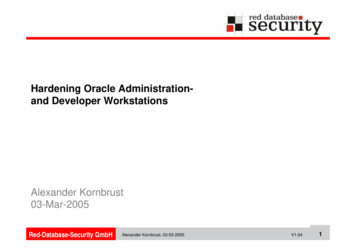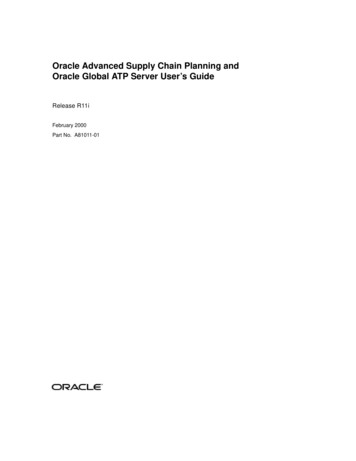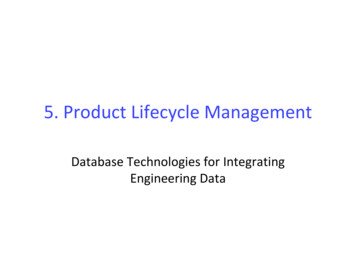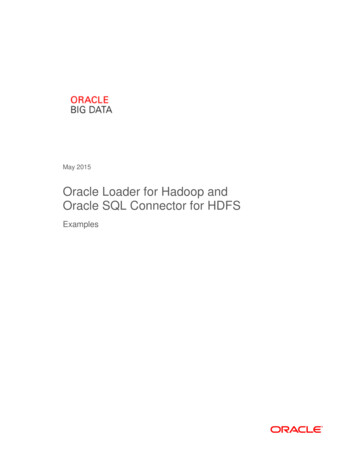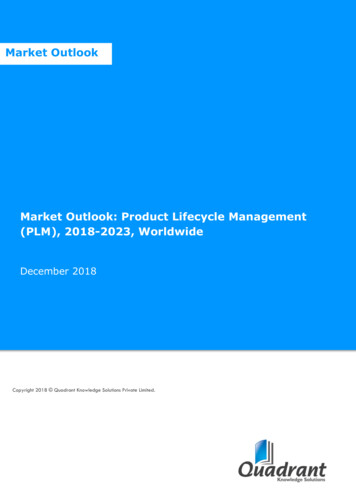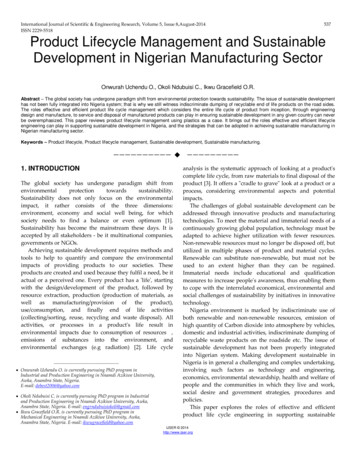
Transcription
GUIDEProductLifecycleManagement
Table of Content1. P roduct Lifecycle Management (PLM)for the innovation battleground Changes in customer expectations have led to theneed to innovate, develop, and commercialize productofferings faster.3. D rive faster, higher-quality innovationthrough commercialization PLM needs to be unified on a common platform—frominitial idea and design through service—to help youdrive faster innovation and shift your business forward.5. Outcome-driven PLM Organizations are tapping the benefits of a modernPLM solution, from finding and selecting better ideasto moving to new business models and getting tomarket faster.2. Where legacy systems fail Today’s shift from selling products to offering them as aservice requires capabilities that traditional, on-premisesPLM systems weren’t designed to deliver.4. P LM ties the digital thread and enablesdigital twins PLM forms the foundation for the digital thread and digitaltwins to make enterprise-wide visibility possible.6. O racle is your partner on the path toPLM success Oracle Cloud PLM helps align design, planning,manufacturing, and service processes, giving youthe foundation to support business transformations
1. Product Lifecycle Management(PLM) for the innovation battlegroundInnovation has become the new battleground for today’s top companies. But finding great ideas,choosing which to invest in, getting them to market quickly and optimizing them over time is farfrom easy. Most companies can’t tell you whether or not their product functions are deliveringa proper return on investment. Lacking this visibility, how can you strategically invest in newproduct development without being concerned about stifling top-line revenue growth?As we continue moving towards an “anything-as-a service” economy that delivers on customerexpectations, a big part of revenue hinges on not only your products’ success, but also thesuccess of its embedded software. Managing these product and service lineups requires you tohave a holistic and connected view from innovation throughout your supply chain. As a result,many companies are quickly discovering that their old PLM systems are making it even morechallenging to keep pace and are turning to cloud-based PLM software that’s ready to help thembuild a resilient global value chain that’s more adaptable and responsive.“ Because manufacturers can continuously monitor productsin use, they can update their products, patch problems,and rethink functionality—all of which improves customersatisfaction. The intelligence from smart, connectedproducts can also inform future product features and newproduct development. We are all familiar with automaticapp updates on our phones, giving us access to newfeatures or fixing problems over the air. Smart, connectedproducts can update themselves in the same way.”Shreenivasa Chakravarti,Global Head, Manufacturing Innovation and Transformation,Tata Consultancy Services
2. Where legacy systems failThe industry has talked about PLM managing the enterpriseproduct record for years. The reality is that legacy PLM systemsonly create a consolidated product development record, but datastill remains fragmented across many siloed applications andthroughout product development, manufacturing, maintenance,and quality management. As the speed of innovation acceleratesand customers are demanding more fulfilling experiences andpersonalized products, many companies mistakenly think thatthey can establish additional manual controls and build heavycustomizations on top of their current PLM software to keep up.Attempts at doing this have only led to increasing IT costs andcomplexity, without tangible business improvements.The problem is that these legacy systems weren’t designed tomeet the digital requirements for today’s innovation processes—they’re engineering-centric, do a poor job of managing thecomplexities of global product launches, and aren’t built tosupport complete service offerings such as ‘products as aservice’ (PaaS). Because traditional PLM systems require theseextensive customizations to meet today’s dynamic businessrequirements, product innovation ends up being confined withinthe product development team.But just in the last few years Product development has become customer focused, meaningcompanies need to quickly shift from selling just products toofferings increasingly defined as products, software, or services.The data walls between PLM, Supply Chain, Manufacturing, andcustomer experience have to dissolve to support the velocity andresilience of new business models and continuous innovation.Recent product development research by engineering.com shows that whenasked about the anticipated benefits of how an integrated cloud PLM solutionwill affect their businesses, respondents said that 10 out of 11 benefits will resultin moderate to revolutionary impact on their product development. Yet as itstands today. Only 32% of development teams have access at any time to product dataacross the product lifecycle (engineering.com) 54% of product development teams lack proper tools for tracking datasourced as part of the development process. Only 34% of product development teams can check their performanceagainst key performance indicators (KPIs) in real time.
3. Drive faster, higher-qualityinnovation through commercializationNew technologies, products, services, and business models are evolvingquickly. Your company’s viability depends on how fast you can innovate andcommercialize successful, profitable products and services that customerswant. But innovation isn’t waiting around.With today’s product offerings coming in many flavors, PLM must evolve tobecome a smart, connected platform that can deliver the velocity neededto support digital transformation and drive faster product launches. Theelements of a modern PLM platform are essential for companies whodepend on innovations to help them grow. A modern PLM solution unifiesprocesses allowing for a seamless flow of data from idea capture to design,all the way through manufacturing and service so you can accelerate globalproduct launches and time to market share.What are the essential elements of a modern PLM?Innovation managementProduct developmentQuality managementProduct master data managementConfigurator modeling
BackInnovation managementFaster InnovationCapture and invest in the right ideasProfitable innovations, fasterManage requirements and conceptsDrive faster, smarter innovation and ensure sustainablegrowth. Oracle Cloud PLM helps you maintain a profitableinnovation pipeline fueled by a steady stream of thehighest-value, on-target, and relevant ideas.Document, prioritize, and agree on requirements that can beleveraged in developing innovation concepts. Reuse existingitems, trace requirements through design, and validate thateach has been met to reduce new product introduction risks.Capture ideas from any sourceBuild agility into innovation portfoliosCapture ideas from any source for new products, services,markets, or customer experiences. Evaluate each proposalacross a 360-degree perspective of resource needs,assessed value, cost, and constraints.Balance core, adjacent, and transformational innovationinitiatives while aligning your resources, risk mitigation,and budgets. Use best-practice analysis to select aninnovation portfolio that achieves your strategic andprofitability objectives.
BackProduct developmentAccelerate product developmentManage development product record and processesRapidly develop and launch productsAccelerate change managementGain faster, more efficient product development and launchprocesses. Bridge traditional, disconnected engineering, R&D,and manufacturing functions by managing an integratedenterprise product record.Effectively manage and model change iterations with acollaborative change management process. Eliminaterework and compress cycle times by configuring definedworkflows with the flexibility to make changes if needed.Minimize design costEnforce product complianceGain complete visibility into your product’s evolution bymonitoring product iterations. Get feedback sooner andavoid costly rework with more effective collaborationinternally and with your design partners.Enforce product compliance and proactively track changesthroughout your product’s lifecycle so you can quickly adjustto changing global standards, efficiently manage engineeringdocumentation, and design compliant, finished productsReduce supply risksReduce supply risk and track part preferencesfor manufacturing throughout each stage of designby maintaining a single view of qualified partsand suppliers across the entire product structure.
BackQuality managementManage the quality of your productsDrive down the cost of qualityClosed loopCentralized document managementImprove the productivity, quality, and profitability of yourprocesses and products. Drive closed-loop quality processesthrough design, procurement, inventory, manufacturing,and field service to ensure rapid detection and resolutionof quality issues.Manage standard operating procedures and industryregulations with a single source of truth that integratestraining, document management, and change control todrive operational consistency, compliance, processimprovement, and audit readiness.Data-drivenIntegrated issue managementMake faster, more-informed decisions and reduce risk witha predictive and connected 360-degree view of productquality across product lifecycle and supply chain processes.Drive greater efficiency with consistent controls of yourquality processes. Capture, aggregate, and performroot-cause analysis on quality issues raised from sourcesincluding the Internet of Things (IoT), field service,incoming inspections and work-in-process inspections.ProactiveRapidly respond to issues, prevent their reoccurrence, anddrive continuous improvement with closed-loop correctiveaction processes that are tightly integrated with your productdevelopment, enterprise change, document management,and inspection processes.
BackProduct master data management (MDM)Harmonize product dataOrchestrate launch to hit your targets and capture the best ROIProduct commercializationIntegrated collaboration for external usersEfficiently commercialize new products and servicesby sharing the right product data required for yoursales, marketing, supply chain, and financial processes.Automate and deliver continuous business rule validationsand verification of data to allow global contract manufacturersand suppliers to receive accurate information and authenticatethe data they provide—no matter where they’re located.Item masteringKeep your item master data clean and synchronized acrossapplications, data pools, and partners with a best-practiceproduct information management process and flexibleattribution, change control, and native governance capabilities.Omnichannel commerceEnsure that complete and consistent product informationis published across your sales channels while efficientlysharing trusted product data across SCM, ERP, and orderfulfillment systems.Centralize and consolidate product dataGain a single platform to centralize and consolidate productdata without disrupting ERP and supply chain operations.A modern PLM can help you unify data from the numerousERP systems that can result from organic growth, mergers,and acquisitions.
BackConfigurator modelingModel complex productsOptimized user experienceModel behavior simulationsBuild better user experiences by guiding your customers tovalid product configurations. Use display condition rules anda variety of selection controls to dynamically control how yourcontent is displayed in the user interface.Design, build, and test business logic and model behavior andoverall user experience prior to release. When releasing newversions, you can leverage comprehensive impact analysisand validation checks to ensure quality.Templatized designSimplified sales processQuickly create the dynamic runtime user interface thatbest meets your needs by choosing from predefined userinterface templates.Guide your customers to the right products. Simplify theconfiguration process by adding high level questions andtying the answers directly to one or more options.
The six defining traitsof modern PLM cloudapplications1Integrated and intelligent.Connect design through service processes—from capturing your initial idea through maintainingproducts and services—all on a single data model for faster decision-making. Modern PLMleverages social monitoring, (IoT), digital twins, artificial intelligence, and quality data to closethe data latency and information gaps between the product and the customer.23456Innovation driven.Empower smarter innovation with the tools needed to streamline, translate, optimize, andexecute a balanced and achievable portfolio targeted to deliver winning offerings matchedto growth strategies. Tightly link the voice of the customer with the voice of the productinto the enterprise product record to enable faster, smarter decisions and traceability.Collaborative.Efficiently view and share information from any device in real time across internal andexternal teams while developing and managing new products and engineering changerequirements. Cloud PLM delivers a flexible user experience that encourages collaborationthrough social, mobile, AI, and chatbot-enabled applications.Purpose built.Reduce the need to staff an entire IT department for new product introductions andproduct launches. Uses embedded solutions for configurability and delivers a single sourceof truth on a common data model across applications, for complete visibility.Continuously improved.With rapid and unpredictable change, Cloud PLM is continuously updated to ensure thelatest innovations are always built in without disrupting your business.Secure.Use leading security technologies to implement and manage consistent security policies.Exercise positive controls to ensure that key data assets are formally managed andgoverned throughout the enterprise
4. Digital: PLM ties the digital thread and enablesdigital twins4a. How modern PLM delivers the digital threadTechnological advancements that enable businesses to respond to change quickly are driving new businessmodels, digital transformation, and Industry 4.0. Modern PLM software provides the core foundation andintersection of critical, cradle-to-grave product lifecycle processes woven with real-time data from technologiessuch as IoT, AI, and machine learning (ML). Global organizations are leveraging what emerged as a “digitalthread” and “digital twins” to change how they design, manufacture, and service products.The digital thread can be defined as a collaborative, single data platform that ties together all elements of theenterprise and its data to produce a holistic view of a product’s physical and digital journey throughout itslifecycle. The digital thread helps break down the walls created by disparate and siloed systems and reduces thelatency and complexities of having to gather information across supply networks and share it at every step of theproduct value chain, including early product design, operations, manufacturing, service, and end of life. Today’sPLM software provides the digital thread you need to access the right information, delivered to the right people,at the right place and time—breaking down organizational barriers to unlock speed and agility while ensuring thehighest product quality.4b. How modern PLM supports digital twinsSimply put, a digital twin is a digital representation of a physical asset. Digital twins leverage the aggregation ofcurrent, historical, and representational data of a product to reflect its real-world use. When a physical object’sdata is made available, a digital representation—a digital twin of the same object—can be simulated to modelthe behavior of the object as it’s designed, built, maintained, or manipulated, creating a virtual profile of theobject at every step of a product’s lifecycle.As data continues to be collected across the product lifecycle—data from customers, factories, IoT sensors,AI, ML, PLM, and operations—it’s woven into the digital thread and the digital twin becomes more accurate.Digital twin technology provides invaluable, real-time updates that enable organizations to identify and analyzea problem in an asset or in the production line, and fix it quickly. Companies that have adopted digital twinsgained significant competitive advantage through eliminating unplanned downtime, which reduces cost andimproves product quality and customer experience. This is only possible with a modern PLM.“ Oracle has taken a differentapproach by rewriting itsERP, PLM, SCM, customerexperience (CX), and IoTapplications on a unifiedcloud platform. With thisapproach, Oracle is providinga single enterprise recordthat spans all enterprisecloud applications, creatingan expansive digital threadthat runs through the entireproduct lifecycle.”CIMdata,Leading PLM analyst firm
5. Outcome-driven PLMInnovate and get to market fasterIncrease return on investmentAccelerate new product introduction by efficiently managing design,requirements, and engineering change orders while enhancing and unifying theenterprise product record across the supply chain and into commercialization.Get early visibility into the success or failure of your idea with the abilityto shift from failing projects to higher-value opportunities, and gain deepinsights to optimize your innovation portfolio.Accelerate product developmentEnsure customer satisfactionEfficiently develop and manage new products and engineering changerequirements while enhancing your product record through item andapproved manufacturer list (AML) management, bill of materials (BOM)management, change management, and supplier collaboration.Close data latency and expectation gaps between the product and thecustomer, leveraging the voice of the customer, social monitoring, and voiceof product, IoT, digital twins, AI, digital assistants, and quality assessment.Configure complex, multi-option, and customizable products and services.Simplify requirements managementEnsure product complianceEnsure your design meets requirements by utilizing powerful guided sellingand configuration solutions that enable flexible modeling of configurable,multi-option, and customizable products and services.Enforce product compliance and proactively track changes throughout yourproduct’s lifecycle so you can quickly adjust to changing global standards,efficiently manage engineering documentation, and design compliant,finished products.Harmonize product dataEnsure product qualityEstablish governance and publish product master data for globalizedmanufacturing and omnichannel commerce. Seamlessly syndicate data tointernal and external applications and marketplaces with a single, multidomainsolution, delivering trusted and commercialized product information.Manage closed-loop quality at every step of design through service withbuilt-in, enterprise-ready, closed-loop quality management to define, identify,analyze, and correct quality events and improve the overall effectiveness,safety, and profitability of your products and services.Reduce costsScale rapidlyFree your CapEx and channel your resources toward building new productsinstead of maintaining and customizing IT systems.Overcome scale constraints imposed by legacy systems and rapidly scaleyour business processes as they grow to ensure consistently great customerexperiences.
6. Oracle is your partner on the path to PLM successOracle Cloud PLM is built and delivered on a software-as-a-service (SaaS) model, meaning it’s always kept upto date with the latest features, functions, and best practices. Cloud PLM rolls out updates regularly, so you’recontinuously leveraging the latest innovations. Access to these new capabilities means you get immediate valuefrom built-in, predictive analytics, AI, ML, IoT, and digital assistants that work together to create 3D models anddigital twins that turn data into preventive, predictive, proactive, and prescriptive insights.Oracle Cloud PLM helps Broadcommanage complex product launches andget to market fasterOracle Cloud PLM delivers visibility through a true digital thread—aligning design, planning, manufacturing,and service processes—to provide the foundation to support business transformations. When PLM is unified ona common platform across ERP, SCM, supply chain planning, manufacturing, maintenance, IoT, and customerexperience, you can drive faster decisions and maximize ROI with higher-quality innovations throughout andafter product launch, while remaining resilient when markets change.Symantec replaced Agile and multiple othersystems with Oracle Cloud PLM to simplifytheir process and reduce go to market timefrom 3 to 4 weeks to 3 to 5 business days.For more informationPlease visit: ht 2021, Oracle and/or its affiliates. This document is provided for information purposes only, and the contents hereof are subject to change without notice. This document isnot warranted to be error-free, nor subject to any other warranties or conditions, whether expressed orally or implied in law, including implied warranties and conditions of merchantability or fitness for a particular purpose. We specifically disclaim any liability with respect to this document, and no contractual obligations are formed either directly or indirectly by thisdocument. This document may not be reproduced or transmitted in any form or by any means, electronic or mechanical, for any purpose, without our prior written permission. Oracleand Java are registered trademarks of Oracle and/or its affiliates. Other names may be trademarks of their respective owners.
1. Product Lifecycle Management (PLM) for the innovation battleground Changes in customer expectations have led to the need to innovate, develop, and commercialize product offerings faster. 2. Where legacy systems fail Today’s shift from selling products to offering them as a se






